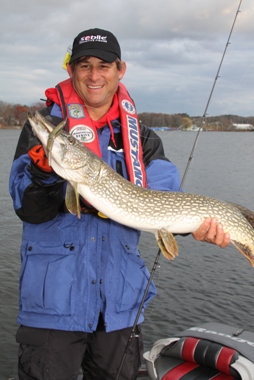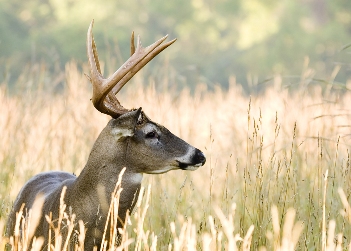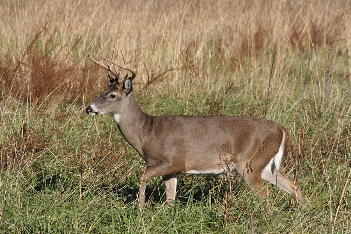Part 1 – The Fish Known As “The Water Wolf”

Monster pike are still taken from select lakes in Canada, such as this giant caught by guide Blaine Anderson on his annual trip to God's Lake Lodge.
“Eeekkk!” The shriek was heard ‘round the lake. The utterance came from my wife, Marilyn, startled by alligator-like jaws that shot up and snapped shut on her spinnerbait as she lifted the lure from the water for another cast. For a moment I thought she was going to surrender the rod to the fish, but she held on.
“Drop the rod tip, hit the free-spool button and thumb the reel,” I shouted almost as loud as her scream. But that advice came too late. With a quick twist of its muscular body the pike broke the line and the green monster disappeared as quickly as it appeared, but now carrying a jewelry memento in its lip.
That fishing trip to Ontario was my wife’s first encounter with northern pike. Today, 36 years later, Marilyn still reacts with the same exclamation to an airborne strike at boat-side. But she has learned not to attempt winching the fish over the side of the boat. Now the majority of those last second attacks are eventually landed.
As far as I’m concerned, shrieking is a justified response to those acrobatic mid-air strikes. On more than one occasion, I have been known to emit a verbal utterance of surprise. It’s all part of the fun and lore of pike fishing.
The only freshwater gamefish with circumpolar distribution (North America, Europe & Asia), scientist believe the northern pike probably evolved in Europe between 60 and 120 million years ago. No other fish species is as steeped in mythology.
The pike was called the “waterwolf” by early Europeans due to its evil-looking eyes. It was once thought that pike were bred from weeds and hatched by the sun’s heat. In medieval times, pike were blamed for attacks on swans, men and even mules that wandered into the shallows of a lake. In some areas, pike bones were worn as talismans against witchcraft.
In North America, the northern pike’s original range included much of Canada, down through New England, back across the Great Lakes states and into the upper Mid West. Pike have been intentionally or accidentally transplanted to areas beyond this range.
Pike can survive in both lakes and large river systems as long water temperatures, spawning habitat and prey source are suitable. They are among the fast-growing gamefish, literally eating machines that feed on whatever preyfish is most abundant. With a spawning temperature in the mid 40s, and sluggish eating habits when water temperatures go above 70 degrees, the species does best in cooler and deeper waters of northern U.S. and Canada where 20-pound-plus fish are possible.
In some regions, the northern pike is disliked by anglers targeting other species. This is particularly true on lakes where the environment is not conducive to growing large pike. In these fisheries, juvenile pike in the 10 to 20 inch range become a nuisance for anglers trying to catch bass or panfish.
But you’ll never hear a complaint from anyone who has tagged a decent-size pike. The ferocity of the strike and an acrobatic show when hooked are enjoyed by many, including my wife who looks forward to our pike-fishing outings each year during cooler water temperatures when pike are shallow and aggressive.
Part 2 – How to Fish for Cold Water Pike
Our pike adventure this past year took us to the Connecticut River to fish with guide Blaine Anderson. I had been surprised to learn about this impressive northern pike fishery in southern Connecticut. But the pictures offered up by this knowledgeable guide was proof that big pike lived in this tidal river.
Blaine’s pike fishing tips for the coldwater period are applicable for northern pike fisheries everywhere.
“During fall and early spring, anglers should fish lures slowly and deliberately,” explains Anderson. “Although pike feed heavily during this period, they don’t like to work hard for a meal. Retrieve lures at a slow to moderate speed so fish can intercept them easily. Cover every square foot of an area before moving on.”
Blaine carries three rods rigged with different lures with each of the baits providing a different action and color. Before changing locations, he offers each of the baits to the resident fish. Some days the fish prefer one style of lure over another, but you can never be sure which will be the most productive bait until you have thoroughly strained the area with all three.
Lure #1 Soft Plastic Jerkbait
On one rod is a large soft plastic jerkbait between 7- and 10-inches. It will be rigged on a large offset weighed hook. The Lunker City Fin-S and Slug-Go are his favorites, often in baitfish pattern. Other times, simply switching to an outrageously bright color like bright yellow or pink might be the ticket. These lures are fished with a sub-surface sashay retrieve over submersed weedbeds. An intermittent pause in the retrieve that allows the soft plastic bait to sink slowly as if injured can be a critical trigger for a strike.
Lure #2 Hard Body Minnow
Anderson’s second rod will have a hard body minnow imitating bait that can be fished several feet below the surface. A large suspending stickbait with saltwater-quality hooks is one possibility, such as a size 14 Rapala XRap.
But he often switches from a suspending minnow bait to a jointed hard body swimbait – a style that originally was developed for big bass waters in California and Texas. The Sebile Pro Swimmer or Reaction Strike swimbait are at the top of his list.
Lure #3 Large Spoon or Spinner
For the third rod, Anderson recommends a large spoon or spinner – something with a lot of flash. From stout-wire spinnerbaits to a trusty Mepps Bucktail, flash has always been a draw for pike. Anderson would not leave home without a good-old Dardevle Spoon, which over the years in North America may have been responsible for more big pike than any single lure.
“Always fish the lure ALL the way back to the boat,” stresses Anderson. “I can’t tell you how many pike are caught right beside the boat as you are lifting the bait from the water. Explosion strikes we call them. That’s one of the things that really make pike fishing exciting.”
I admit to be being nervous when it comes to pike and lures with treble hooks. Unhooking any lure from the toothy mouth of a slippery, struggling pike is a challenge, but when two or three treble hooks are thrown into the mix, the chance of injury to the angler increases. If a single hook lure can draw the strikes, then I’m most likely going to select that one. For example, when choosing a swimbait for pike, I prefer a large profile soft body one such the Yum Money Minnow or the new Sebile Soft Swimmer.
When lures are tied directly to line under 15-pound test, pike bite offs are fairly common. Therefore some type of leader should be used. Anderson fishes 20 or 30-pound braided line with a shock leader of 50-pound fluorocarbon. He rarely loses a pike to a bite off.
When using standard bass tackle for pike, I employed a simple 15-inch black nylon-coated wire leader with a swivel on one end and a snap on the other to convert my outfit to pike fishing. However, after being introduced to the new super thin, low visibility Liquid Steel Leaders from Castalia, I am making a switch.
If you want something different from crappies or bass, check out the excitement of pike fishing on Blaine Anderson’s website.
About Darl Black
Angling writer and photographer Darl Black has been fishing since he was old enough to hold a cane pole. Through a 20-year career of outdoor writing, he has been published in numerous freshwater angling magazines across the USA.
Keep up with Darl’s latest exploits at his blog
What do you think? Ever catch a pike?
27,225 total views, no views today









